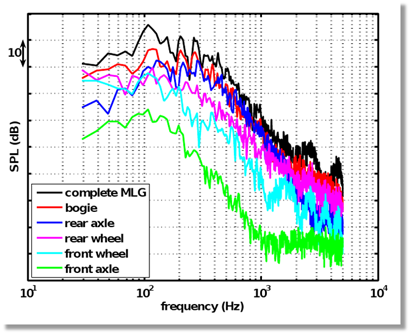Computational methods are used to determine the flow field around a simplified landing gear geometry and the far field noise levels generated by this flow. The focus of this research is on the influence of bogie inclination angle on the flow features and the far field noise level.

Figure 1: Main landing gear geometry with the bogie beam highlighted in red.
Airframe noise is one of the main noise sources during the approach phase. Flight tests have shown that for large aircraft the main landing gear (MLG) is a dominant airframe noise source . The design of landing gear is primarily focussed on its mechanical function which results in a shape that is not very aerodynamic. This creates a lot of separated and turbulent flow and thus a lot of aeroacoustic noise. Wind tunnel tests have revealed that the bogie beam (see Figure 1) as one of the most important noise sources of the main landing gear.
The main objective of the project is to investigate the influence of bogie beam inclination angle on the flow field around the main landing gear and the noise generated by this flow. This should lead to a better understanding of which flow features are responsible for the noise. The knowledge acquired during the project will help to design low noise landing gear in the future.
Detached-eddy simulation (DES) of the flow around a simplified landing gear model is performed. The geometry used in the first simulation has the bogie beam aligned with the flow. The on-surface unsteady pressure data collected during the simulation is input into a Ffowcs Williams and Hawkings solver to determine far field noise levels
The computational results agree with the wind tunnel tests that the bogie the dominant noise source of the landing gear is (see figure 3) . Simulations using the same geometry but with different bogie inclination angles are on-going and will reveal the influence of bogie inclination on the flow features. The complexity of the geometry will be increased for future simulations.

Figure 2: Mean pressure coefficient on the simplified landing gear.

Figure 3: Far field noise levels below the landing gear.
This project is on-going. The results of the simulations agree with experimental results which makes it a valid tool to investigate airframe noise. The on-going and planned simulations will give more insight in the flow features which are responsible for the noise around the bogie beam.